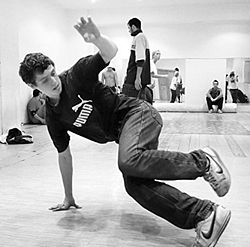There are four primary elements that form breaking. These include toprock, downrock, power moves, and freezes/suicides.
Toprock generally refers to any string of steps performed from a standing position. It is usually the first and foremost opening display of style, though dancers often transition from other aspects of breaking to toprock and back. Toprock has a variety of steps which can each be varied according to the dancer's expression (ie. aggressive, calm, excited). A great deal of freedom is allowed in the definition of toprock: as long as the dancer maintains cleanness, form and the b-boy attitude, theoretically anything can be toprock. Toprock can draw upon many other dance styles such as
popping,
locking, or
house dance. Transitions from toprock to downrock and power moves are called drops.
[20] Downrock (also known as "footwork" or "floorwork") is used to describe any movement on the floor with the hands supporting the dancer as much as the feet. Downrock includes moves such as the foundational
6-step, and its variants such as the 3-step or other small steps that add style. The most basic of downrock is done entirely on feet and hands but more complex variations can involve the knees when
threading limbs through each other.
Power moves are acrobatic moves that require
momentum, speed, endurance, strength, and control to execute. The breaker is generally supported by his upper body, while the rest of his body creates circular momentum. Notable examples are the
windmill,
swipe, and head spin. Some power moves are borrowed from gymnastics and martial arts. An example of a power move taken from gymnastics is the
Thomas Flair which is shortened and spelled
flare in b-boying.
Freezes are stylish poses, and the more difficult require the breaker to suspend himself or herself off the ground using upper body strength in poses such as the
pike. They are used to emphasize strong beats in the music and often signal the end of a b-boy set.
Freezes can be linked into chains or "freeze ladders" where breakers change positions to the music to display musicality and physical strength.
Suicides like freezes are used to emphasize a strong beat in the music and signal the end to a routine. In contrast to freezes, suicides draw attention to the motion of falling or losing control, while freezes draw attention to a controlled final position. Breakers will make it appear that they have lost control and fall onto their backs, stomachs, etc. The more painful the suicide appears, the more impressive it is, but breakers execute them in a way to minimize pain.
Power versus style
Multiple stereotypes have emerged in the breaking community over the give-and-take relationship between technical footwork and physical power. Those who focus on dance steps and fundamental sharpness are labeled as "style-heads." Specialists of more gymnastics-oriented technique and form—at the cost of charisma and coordinated footwork—are known as "power-heads." Such terms are used colloquially often to classify one's skill, however, the subject has been known to disrupt competitive events where judges tend to favor a certain technique over the other.
This debate however is somewhat of a misnomer. The classification of dancing as "style" in b-boying is inaccurate because every b-boy or b-girl has their own unique style developed both consciously and subconsciously. Each b-boy or b-girl's style is the certain attitude or method in which they execute their movements. A breaker's unique style does not strictly refer to just toprock or downrock. It is a concept which encompasses how a move is executed rather than what move is done.
PIC 2 adalah aku time aku muda2 dulu..masa remaja sekolah....hahaha....
SELAMAT MENCUBA...




























